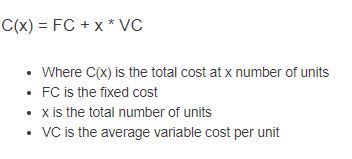Enter the fixed cost, variable cost per unit, and the total number of units produced into the calculator to determine the total cost using the cost function.
- Fixed Cost Calculator
- Average Variable Cost Calculator
- Conversion Cost Calculator
- Cost Performance Index Calculator
Cost Function Formula
The following is the typical cost function associated with producing goods.
C(x) = FC + x * VC
- Where C(x) is the total cost at x number of units
- FC is the fixed cost
- x is the total number of units
- VC is the average variable cost per unit
To calculate the cost from the cost function, add the fixed costs to the product of the number of units times the variable costs per unit.
This is considered the most standard cost function, but a cost function can be any function defined by a company that accurately predicts costs.
How Do You Define a Cost Function?
The cost function is a formula that people use to tell how production expenses will change at different intervals.
In other words, the cost function is used to estimate the relationship between the cost and the output.
The cost, in this case, is the expenses needed to manufacture a particular product or offer a service.
The output is the number of units produced or services provided and how much they earned from the production cost.
What Is the Cost Function Used For?
The cost function predicts future expenses by figuring out the average cost per produced unit. It’s incorporated in companies to help people predict how many units they need to sell to profit or at least get back their production cost.
How Do You Create a Cost Function?
There are three main steps to create a cost function, those are:
- Find the fixed costs.
- Find the variable price for each unit.
- Multiply the variable cost average by the number of produced items, then add the fixed costs.
How to Find Fixed Costs
Fixed costs can be done automatically using accounting software. If you’d like to calculate them manually, sum up all the items whose cost doesn’t change and divide them by quantity.
Fixed costs are not limited to produced units. In most cases, they also include rent and administration costs.
How to Find Variable Costs
In short, variable costs are the items that tend to change price over time. Examples of variable costs are raw materials, fuel, supplies, and labor hours.
To calculate the variable cost per unit, divide the total variable costs by the number of units produced. In the case of services or labor, split the total variable cost by the number of services provided.
What Are the Types of Cost Functions?
There are three main types of cost functions, those are:
- Linear cost function
- Cubic cost function
- Quadratic cost function
What Is the Cost Function in Optimization?
In machine optimization or machine learning, cost functions are used to measure the progress of machine learning.
This is done by comparing the predicted values the machine is believed to achieve with the actual values that the machine achieves.
Cost Function Example
For example, a cost function could look something like this: C(x) = FC + (X + VC) 2 . In this case, the total cost is dependent on the total units and variable cost squared.
That means the total cost goes up exponentially with units product. This is not necessarily realistic, but it gives you an idea of how these functions can be used to map total cost.
Let’s look at an example where the cost function is the same as above, the fixed costs are $50, the total number of units is 500 and the variable costs per unit are $30.
Using the formula above, the cost is found to be:
C(x) = FC + x * VC
C(x) = $50 + 500*$30
C(x) =$15,050.00
FAQ
A cost function is any variable function that can be used to predict the total costs of a good or service at any number of units desired.
A cost function is created similarly to the example above. After taking a time period of data of total units and total costs, a line of best fit can be mapped to the data and a function can be created to equal that line.

